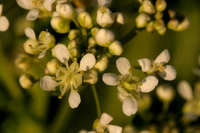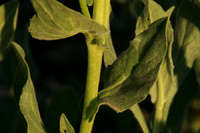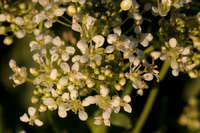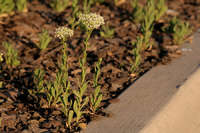- Home
- Search
- Images
- Datasets
- Sample Use
- How to Cite
- Additional Information
- About NEON
- NEON Data Portal
- ASU Biocollections
- About Symbiota
|
|
|
|
Family: Brassicaceae
whitetop
[Cardaria draba (L.) Desv.] |
Perennials; (rhizomatous); hirsute or glabrate. Stems often simple from base, erect or decumbent basally, branched (several) distally, (0.8-)2-6.5 (-9) dm. Basal leaves (early withered); not rosulate; petiole 1-4 cm; blade obovate, spatulate, or ovate, (1.5-)3-10(-15) cm × 10-40 mm, margins sinuate to dentate or entire. Cauline leaves sessile; blade ovate, elliptic, oblong, or lanceolate, oblanceolate, or obovate, (1-)3-9(-15) cm × (5-)10-20(-50) mm, base sagittate-amplexicaul or auriculate, margins dentate or entire, (surfaces pubescent or glabrous). Racemes (corymbose panicles), slightly or considerably elongated in fruit; rachis glabrous or puberulent, trichomes straight or curved, cylindrical. Fruiting pedicels ascending to horizontal, straight, (terete), 5-10(-15) × 0.2-0.3 mm, glabrous or sparsely puberulent adaxially. Flowers: sepals oblong to ovate, 1.5-2.5 × 0.7-1.2 mm; petals white, obovate, (2.5-)3-4(-4.5) × (1-)1.3-2(-2.2) mm, claw 1-1.7 mm; stamens 6; filaments 2-3 mm, (glabrous); anthers 0.4-0.5 mm. Fruits (indehiscent), cordate to subreniform, (2-)2.5-3.7(-4.3) × (3.2-)3.7-5(-5.6) mm, apically (obtuse to subacute), not winged, apical notch absent; valves thin, smooth, reticulate-veined, glabrous; style (0.6-)1-1.8(-2) mm. Seeds ovate, 1.5-2.3 × 1-1.3 mm. 2n = 32, 64. Flowering Apr-Aug. Mountain slopes, roadsides, fields, agricultural lands, stream sides, disturbed grounds, pastures, waste areas; 0-3300 m; introduced; Alta., B.C., Man., N.S., Ont., Sask.; Ariz., Calif., Colo., Conn., D.C., Idaho, Ill., Ind., Iowa, Kans., Md., Mass., Mich., Minn., Mo., Mont., Nebr., Nev., N.J., N.Mex., N.Y., N.Dak., Ohio, Okla., Oreg., Pa., R.I., S.Dak., Utah, Wash., Wyo.; s Europe; sw Asia; introduced also in Mexico (Distrito Federal), South America, s Africa, Australia. Although Lepidium draba is poorly established and known from old collections in the eastern part of the United States, it has become a noxious weed in several western states. Lepidium draba and its nearest relatives, L. appelianum and L. chalepense, form a monophyletic clade most closely related to L. campestre (K. Mummenhoff et al. 2001). A. Thellung (1906) and C. L. Hitchcock (1936) correctly placed L. draba in Lepidium, as did Linnaeus. The recognition of the first three species in Cardaria and the maintenance of their nearest relative, L. campestre, in Lepidium do not make any sense on both phylogenetic and taxonomic grounds.
Perennial herb with a thick taproot to 0.6 m tall Leaves: alternate, ascending or upright, clasping, stalkless, to 9 cm long, to 4 cm wide, reduced in size up the stem, oblong to lance-shaped or egg-shaped, bases lobed, tips pointed, sometimes irregularly toothed, densely hairy. Flowers: in dense, branched clusters (raceme), which are borne terminally on the stems. Racemes numerous, often forming a white top across the apex of the plant. Sepals four, free (not attached), whitish green, 2 - 2.5 mm long, to 2 mm wide at apex, hairless or nearly so. Petals four, free (not attached), typically spreading, white, 3 - 4 mm long, bases narrowed. Stamens six. Anthers yellowish orange. Fruit: a short, indehiscent pod (silicle), 2.5 - 3 mm long, 3 - 5 mm wide, nearly spherical, tips pointed, bases heart-shaped, somewhat flattened, hairless or nearly so, evenly divided into two valves. Seeds one per chamber. Stems: multiple from base, vigorously spreading, upright, typically unbranched (but branched in the inflorescence), ribbed, densely hairy below, sparsely hairy above. Roots: creeping. Similar species: No information at this time. Flowering: May to mid-June Habitat and ecology: Introduced from Eurasia. A common weed in fields and waste ground. Also look for it along roads and in other disturbed areas. Occurence in the Chicago region: non-native Etymology: Lepidium comes from the Greek word lepis, meaning scale, which refers to the shape of the silicles. Draba comes from the Greek word drabe, meaning sharp or acrid, which refers to the burning taste of the leaves. Author: The Morton Arboretum Erect perennial to 6 dm, vigorously spreading by creeping roots, short-hairy below, less so or glabrate upwards, the sep and fr glabrous or very nearly so; cauline lvs oblong to ovate or obovate, ascending or erect, sessile, au2riculate, irregularly toothed or entire, to 9 נ4 cm; racemes numerous, dense, commonly forming a white top across the summit of the pl; mature pedicels 10-15 mm; sep 2-2.5 mm; fr 2.5-3 נ3-5 mm, somewhat inflated but usually constricted at the narrow partition, cordate or subcordate at base; 2n=32, 64. Fields, roadsides, and waste places; native of the Middle East and e. Mediterranean region, now a serious weed in w. U.S. and adj. Can., and occasionally found in our range. May-July. (Lepidium d.) Gleason, Henry A. & Cronquist, Arthur J. 1991. Manual of vascular plants of northeastern United States and adjacent Canada. lxxv + 910 pp. ©The New York Botanical Garden. All rights reserved. Used by permission. Duration: Perennial Nativity: Non-Native Lifeform: Forb/Herb Synonyms: Cardaria draba |
|
|
|












